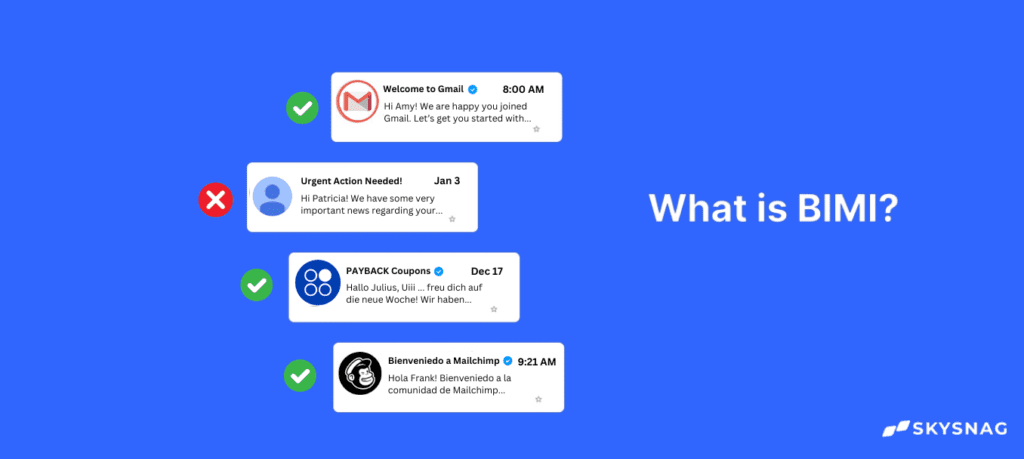The Skysnag Blog

The one tactic that increases your visibility in front of subscribers and increases the likelihood that your message will be opened is what email marketers are constantly looking for: the silver bullet. A developing email standard called Brand Indicators for Message Identification, or BIMI for short, can help your brand stand out in the inbox with a verified blue checkmark and logo.
What is BIMI?
BIMI is a specification that permits the placement of brand logos next to verified emails. BIMI confirms brand-related information stored in your server. In fact, it works hand in hand with SPF, DMARC, and DKIM to let email clients know that you are who you say you are. As a result, it also helps with deliverability. BIMI assists in increasing brand identification and trust, in addition to increasing brand visibility.
Here’s a list of mail clients supporting BIMI, as of September 2022.
How does BIMI work?
It is just a text file, just like other email authentication standards. This text file resides on your sending servers and has a specified format.
The recipient’s email service checks the BIMI text file’s location when a message is delivered to make sure it can be validated. When the BIMI file has been validated, the email service is informed where to locate the sender’s logo and the logo is then pulled into the inbox.
Although the basic idea behind BIMI seems straightforward, there are a few essential components you’ll need to set up:
- Authentication of your emails with SPF, DKIM, and DMARC
- Access to your domain name servers to set up a new BIMI DNS entry
- An SVG file of your logo
- A Verified Mark Certificate (VMC) optional but recommended
Support for BIMI is evolving over time, similar to everything else in the email infrastructure. Taking into account that well-known companies like Google, Verizon Media, and Fastmail are participating, it is evident that more service providers will join the working group and pilot program in the years to come.
How to implement BIMI
Because uniformity is BIMI’s ultimate goal, publishing an SPF, DKIM, and enforced DMARC record is the essential prerequisite. Verify your compliance with all email security protocols necessary for BIMI.
To guarantee uniformity among mailbox providers, logos must also adhere to certain graphical requirements. If you’re curious about how your logo and verified blue checkmark would appear on every email you send, check out your own BIMI – Digital Trademark.
Why does BIMI matter for Email Marketing?
The main objective of BIMI for email marketers is to make it simple for subscribers to recognize reliable email senders so they can trust what lands in their Inbox. Subscribers will quickly be certain that an email from you is genuine when they see your logo with a verified blue checkmark – eliminating the thought of risk and phishing. The brand awareness that comes from seeing logos all the time is wonderful, but the magic is in the trust that goes along with them.
Your email deliverability may also benefit from BIMI. It will offer yet another method to increase your chances of making it into Inbox because so much of modern-day deliverability is reliant on authentication and reputation rather than email content itself.
Conclusion
To add another layer of email protection and to increase brand visibility, configure your email system from phishing attacks using Skysnag’s automated BIMI solution. Get started with Skysnag by signing up for a free trial which will enable you to lay the groundwork for the trust that will help your emails land in the inbox.
Check your domain’s DMARC security compliance
Enforce DMARC, SPF and DKIM in days - not months
Skysnag helps busy engineers enforce DMARC, responds to any misconfigurations for SPF or DKIM which increases email deliverability, and eliminates email spoofing and identity impersonation.